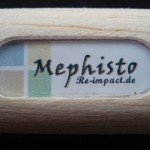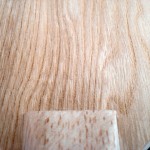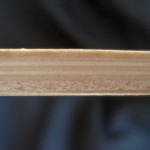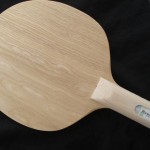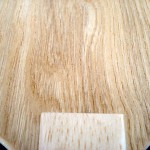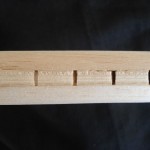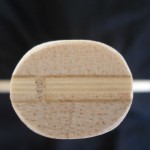The Re-Impact Mephisto Blade
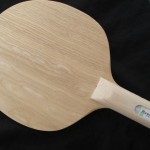 General description:
General description:
Weighing around 65 grams, having a thickness around 6.1 mm, the Mephisto is a controlled combination blade designed for modern defense, offering a clear difference between forehand and backhand. Due to the special plies in its forehand, which doesn’t contain balsa, this side reliably produces heavy spin and moderate speed, as well as high control. The balsa ply in the backhand side of the blade offers an especially good dampening effect, resulting in very low speed and high control.
Suitability for styles:
The Mephisto’s design suits backhand defense close to the table, using long pips-out or anti-spin rubbers, and controlled forehand topspin attack. Due to the balsa’s capacity to absorb incoming speed, backhand blocking works well, but the blade will also support chopping away from the table. Its moderately fast forehand suits loopers that concentrate on heavy topspin more than on speed, but fast incoming balls can be blocked effectively as well, and chopping (due to the high control) is an option too. Consequently, the blade will effectively support every type of modern defense.
Suitability for rubbers:
The Mephisto’s forehand combines well with any type of inverted rubber, and also with short or medium pips-out rubbers. Fast rubbers will add to the – already substantial – difference between forehand and backhand. As there is no balsa-effect on this side, even max thick and tensioned or tuned rubbers can be used, but max thick soft sponges will still tend to produce a ‘mushy’ feeling and low feedback.
As the forehand plies offer qualities consistent with high-spin looping, pips-out rubbers should be very fast and have relatively thin sponge (1.5 to 1.8 mm) if classic pips-out effects are required. If, however, the player’s main needs are speed and relative insensitivity to incoming speed, thicker sponge can be used as well. Chopper-attackers can use their preferred compromise on this blade’s forehand.
The Mephisto’s very slow and controlled backhand combines ideally with well-reversing rubbers, including low-friction anti-spin rubbers, if used for defense close to table. Any type of rubber, with relatively thin sponge, can be used for defense away from the table; however, the speed of the backhand is so low that long-distance chopping would need relatively fast rubbers. Inverted rubbers and short or medium pips-out rubbers should have medium to hard sponge because of the effects of the balsa layer. Thickness of sponge over 1.8 mm is inadvisable.
Idiosyncrasies:
Almost all Re-Impact blades, having been designed for specific purposes, have special properties which are beneficial to the desired style of play, but in some situations may pose unexpected problems.
The balsa ply in the Mephisto’s backhand will absorb speed on soft to medium hard contact with the ball, but if contact is much harder (incoming fast loops or smashes) this side of the blade will become less controlled and faster, although the returned speed will always be low. If the player does not have the technique required for soft-blocking fast incoming balls, it is more effective to counter-block them: with the blade slightly closed and going upward, pressing the ball firmly but without much force forward over the net. As the incoming spin will be reversed on these active blocks, they must not generate too much speed, or else the ball will float and overshoot the table, but with this blade the risk is low.
Slow loops having a lot of spin, which are difficult to handle with most set-ups using OX LP’s, may also be hard to deal with using the Mephisto’s backhand. The ball, being slow and thus contacting the blade rather softly, will lose even more of its speed because of the braking effect of the balsa; added to its high spin, this will result in much higher friction (for a long pimple) if a passive block is attempted, and as a result the ball will tend to be returned too high. As an alternative to blocking, these balls can be safely chopped or chop-blocked aggressively, moving one step away from the table.
Blade Protection:
The blade is sealed; extra sealing is not really required. It won’t do any harm to add some extra protection on the blade’s face, but adding more than two thin layers is inadvisable, as it will harden the feel of the blade. Balsa is very vulnerable and since it is exposed on the edges, it makes sense to protect the edge of the blade. A coating will help some, but better still is thick (or foamed) edge-tape.
Protection of the soft balsa grip using sealing or tape is not advisable, as the blade’s KSLS-system should be in optimal contact with the hand.
Mephisto Pictures:
Below are some pictures of this blade. Click on the image to see the full size version.
- Mephisto logo
- Mephisto backhand (slower side)
- Mephisto backhand closeup
- Mephisto ply structure
- Mephisto forehand (faster side)
- Mephisto forehand closeup
- Mephisto grooves
- Mephisto handle bottom
